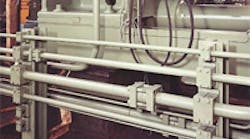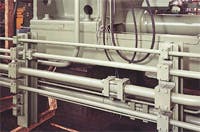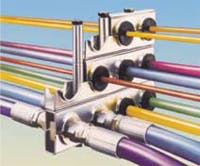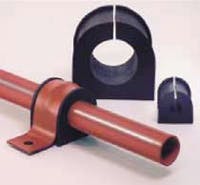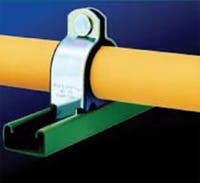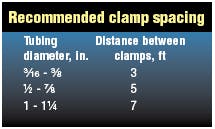Unrestrained hydraulic tubing can emit sound as though it were a tuning fork. Fluid velocity, pressure (and their changes), and line size all contribute to the vibration, line shock, pressure surges, and sound, which are prevalent in many hydraulic machine operations. Shock, pressure surges, and vibration will flex metal tubing. This flexing can cold-work the tubing, particularly around connectors. In extreme cases, cracks in fluid lines can result.
Accordingly, components that hold hydraulic tubing, hose, and pipe in place have progressed from simple clamps to engineered support systems. A properly designed and installed tubing-support system can reduce noise, risk to property and personnel, and environmental damage caused by hydraulic fluid leaking from a damaged line.
— Tubing supports should control vibration and absorb shock. Pumps and valves are the greatest cause of vibration and shock because of the drastic pressure and fluid velocity changes that occur in these components during operation. Although intensive research has reduced pump- and valve-induced vibration, it is still considered a problem for the entire tubing system. Through pipe and tubing can also transmit and amplify vibration, shock, and related noise.
Excessive noise for plant personnel is only one negative effect. More importantly, if tubing, pipe, and hose are not properly supported, vibration may cause fittings and flanges to loosen. This can lead to increased safety risks for plant personnel, downtime, high maintenance costs, inefficiency of the system due to air causing cavitation in pumps and valves, and loss of hydraulic fluid. The economics of hydraulic leaks as a result of loose fittings and flanges can be quite revealing.
Resilient supports
Resilient supports have been developed to damp the vibration in piping systems. Several types of supports are available that absorb shock and vibration to different degrees. These products use various materials — including rubber, metal, and thermoplastics — and designs to accomplish this task. The support systems generally fall into two categories: individual supports that hold single tubes, and multi-clamp assemblies to secure two or more lines. Multi-clamp assemblies may be the only choice if individual lines are too numerous for mounting side by side within allowable space. These systems position lines in rows, or tiers. Either system generally accommodate pipe and tube sizes from 316 to 24 in. They are secured in place with threaded fasteners or to a mounting rail or welded-on base.
Support material The simplest supports to hold tubing runs in place are metal, but they should not be used for hydraulic applications because repeated pressure cycles can cause a slight shift of tubing with every cycle. Over time, the metal tube rubbing against the metal support clamp can wear away enough material to cause a leak. Therefore, metal clamps should have a liner of soft material — such as rubber or plastic — to prevent abrading away tube surfaces. Clamps for hose may be made entirely of non-metallic materials.
Supports made from such thermoplastics as polypropylene or polyamid readily absorb shock and vibration. In addition, they are resistant to chemicals and abrasives, expand and contract with changing temperature, and, at the same time, exhibit relatively high strength. Finally, supports made from thermoplastics are inexpensive.
Multi-tube support systems
Generally, multi-tube clamping systems are manufactured from pressed steel. The tube or pipe is held by a split rubber or plastic grommet located in the steel clamp body; this grommet is held in a steel body by a retaining ring molded into it. This type of clamp is ideal for general hydraulic and pneumatic systems that do not generate excessive high-frequency vibration. These clamps generally accommodate line diameters to 2 in. and temperatures to 250° F. Several models offer the added versatility of interchangeable grommets to hold different size tubing while using the same clamp assembly.
Some multi-tube systems allow fitting inserts or junction adapters to be placed between the clamping halves. These inserts permit the clamp to serve as a bulkhead connector plate or a junction block, tube-to-tube connection, tube-tohose connection, or terminal.
Another feature of some multi-tube systems is fixed center line distances, both horizontally and vertically. This can be an advantage or disadvantage, depending on the installation. The advantage is that it provides uniform spacing between fluid lines for easy installation and maintenance. A disadvantage is that it can consume more space because small fluid lines have the same spacing as larger ones.
Individual tube clamps — Most clamping systems are for clamping individual lines. Single clamps are either fastened directly to a mounting surface at predetermined positions or located in a mounting rail, allowing for adjustment after mounting.
Individual supports can be either molded plastic with identical halves, or made of metal with a rubber or plastic grommet surrounding the pipe or tube. Steel retaining pieces hold the grommet tightly around the pipe and fasten to the mounting plate.
The grommet design allows for quick and easy installation and adjustment, but is not suitable for large diameters or where heavy shock and vibration are present. This style of support cannot be stacked easily.
Thermoplastic supports — Manufactured by injection-molding processes, thermoplastic supports consist of identical upper and lower halves that are held together by one or more steel bolts, often in conjunction with steel bases and cover plates. Using identical upper and lower support halves eliminates potential confusion during installation in the field.
To attach the support, base plates are either tack-welded or, in the case of high-vibration applications, continuously welded to any available structure. To further simplify installation, multi-position rails have been developed to accommodate several individual supports side-by-side without wasting space.
Additional advantages result from breaking down traditional multi-tube clamps into individual supports. Not only are they less expensive and easier to install, but maintenance or moving of pipes and fittings is simplified by providing access to one particular line without disturbing adjacent lines. Some multi-tube clamps solve this problem by cutting the upper half of the unit for convenient removal of several tubes for service.
Individual supports are also well suited to secure tubing in cramped areas. Several of the supports can be stacked on top of each other, resulting in an uncluttered yet efficient use of available space.
Routing
After analyzing your hydraulic system, route tubing by the most direct route, often along the base of a machine. Beware of obstructions, moving parts, contours, and service openings. Plan around them. If this base routing is not economical, consider upright carriers for partial line suspension. If this is not practical, full overhead suspension is the last resort.
How far apart? Manufacturers recommend spacing between clamps as shown in the table. All tubes should be clamped on both sides of a bend, as close to the bend radius as possible. This prevents tube movement if internal hydraulic shock occurs. Following the spacing shown in the table permits a tubing system wall-thickness reduction from 0.095 in. to 0.065 in. with no splitting in the thinner tubing walls.
A well-designed fluid power system will include a tube and pipe support system. The fluid system may be for a single machine, a central system that serves an entire plant, or any size in between. Proper tube support pays dividends — for the designer, the maintenance crew, and plant personnel.
How to mount clamps — Methods of fastening clamps to supporting members vary. Some multi-clamp assemblies can be bolted on, can use a tapped hole, or even can be secured to a suspended column by bolting through special mounting adapters that use tube clamping holes in the clamp assembly.
This article is based on information appearing in the 2006/2007 Fluid Power Handbook & Directory and was updated with input from Rocky Walker, of Hydro-Craft, Henderson, Nev. For more information, visit www.hydro-craft.com.
